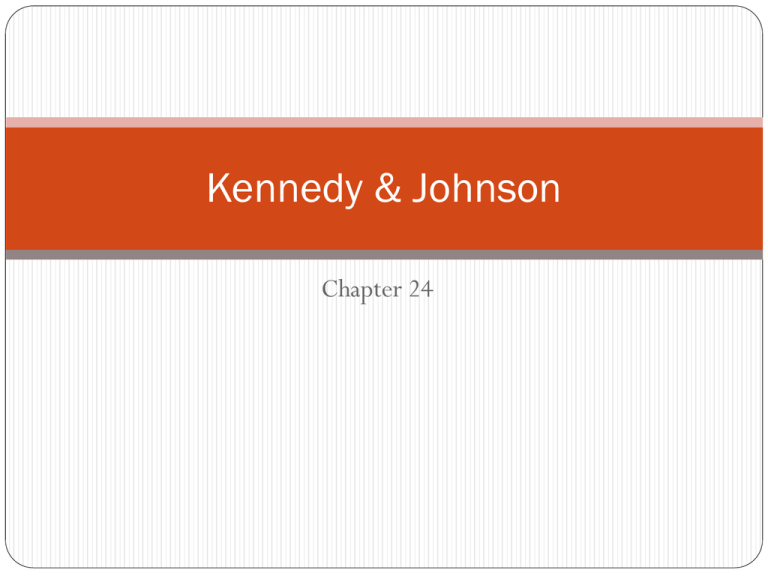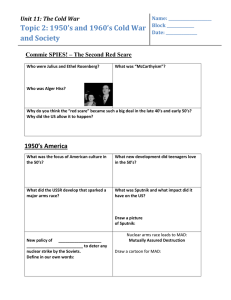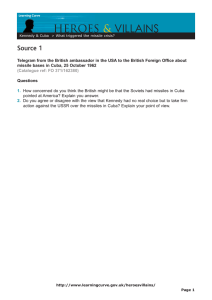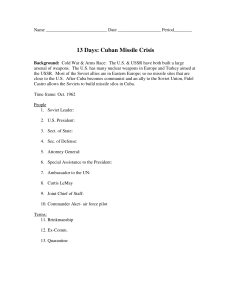Kennedy & Johnson Chapter 24
advertisement

Kennedy & Johnson Chapter 24 Republicans Democrats Richard Nixon John F. Kennedy Rode on success of Youth & energy=Kennedy Eisenhower’s administration mystique. The Election Campaign of 1960 Issues in the Election 1. The Economy & the Cold War Kennedy warned of a “missile gap” Nixon & Kennedy considered themselves “Cold Warriors” – (strong communist fighters) 2. Religion- Kennedy’s Catholicism became an issue; Kennedy addressed the issue in a speech. The Kennedy-Nixon Debates 1st televised presidential debates (72 million viewers) 4 debates total Kennedy appeared to win televised debates ** Both parties spent $6-$7.5 million on TV & radio ads John F. Kennedy 1961 - 1963 *Youngest Candidate Elected as US president Aged 41. “Ask not what your country can do for you – ask what you can do for your country.” Kennedy Policies New Frontier Kennedy’s Domestic programs Increase aid in education, federal support for health & migrant workers, and Civil Rights. • Few of JFK’s programs passed (because he had won by such a slim popular vote margin, few Democrats would go out on a limb to support his ideas) Kennedy & the Economy • US economy in recession when JFK was elected. 1. Cut taxes 2. Deficit spending – encouraged Congress to spend money on Space exploration & defense= more jobs & money in circulation. 3. Kept interest rates low * JKF had the 1st Budget to top $100 Billion The Supreme Court The Warren Court Chief Justice Earl Warren Landmark cases that changed America *Brown v. Board of Education (1954)- desegregation of public schools. Baker v Carr (1962) Federal courts could try cases against states redrawing political district lines. Reynolds v Sims (1964) Most states’ current apportionment was unconstitutional “One Man, One Vote” Mapp v Ohio (1961) Unlawfully seized evidence cannot be used in trial. Gideon v Wainwright (1963) Right to a lawyer Escobedo v Illinois Miranda v Arizona (1966) Miranda rights Engle v Vitale (1962) States could not compose & require recital of official school prayers. Griswold v Connecticut Prohibition of birth control devices violated right to privacy. *Flexible Response Kennedy pushed for a build up of conventional troops & weapons along with Special Forces (Green Berets) Kennedy felt that Eisenhower had relied to heavily on nuclear weapons. *Alliance for Progress Plan to improve relations with South America Create a free Latin America without support of Communist Revolutions $20 Billion over 10 years to Latin America for better schools, housing etc. *Peace Corps Aid developing nations by sending young people to do humanitarian work Kennedy & the Space Race 1957- Soviet Union launched Sputnik- 1st unmanned satellite to orbit the earth. 1961- Soviet astronaut Yuri Gagarin – 1st person to orbit the earth. 1961- Kennedy set a goal that the US would land a man on the moon by the end of the decade. 1962- John Glenn- 1st American to orbit the earth. 1969- 3 Americans landed on the moon; Neil Armstrong (1st man to walk on the moon). JOHN F. KENNEDY BECOMES PRESIDENT OF THE US IN 1961 AND INHERITS A PLANED INVASION OF CUBA FROM THE EISENHOWER ADMINISTRATION • 1959- Fidel Castro & communist revolutionaries toppled the US backed government of Fulgencio Batista & established ties with the Soviet Union. •Eisenhower & CIA trained Cuban exiles for an invasion of Cuba to overthrow Castro. •April 1961- Kennedy carried out the plan- 1,400 exiled Cubans landed at the Bay of Pigs. BAY OF PIGS INVASION SITE • Kennedy cancelled US air support, boats ran aground= disaster!! THE INVASION WAS A FAILURE AND ALL THE CUBAN EXILE INVASION FORCE WAS EITHER KILLED OR CAPTURED BY CASTRO’S ARMY. CASTRO’S FORCES ON THE MARCH CASTRO’S AIR FORCE DESTROYED THE INVADING SHIPS •June 1961- Kennedy & Soviet leader Khrushchev met in Austria. •Khrushchev worried about flow of East Germans leaving & moving to West Berlin. •Khrushchev demanded that US, Britain, & France withdraw from Berlin & recognize the communist government of East Berlin.= KENNEDY REFUSED! VISUAL SYMBOL OF Cold War ( DIVIDE BETWEEN US & USSR) until 1989 IN JUNE OF 1963 PRESIDENT KENNEDY WENT TO BERLIN AND DELIVERED HIS FAMOUS “ICH BIN EIN BERLINER” ( I AM A BERLINER) TO SHOW U.S. DETERMINATION TO KEEP BERLIN FREE. 1962- US INTELLIGENCE BEGAN RECEIVING REPORTS OF SOVIET MISSILES IN CUBA. A U2 FLIGHT ON AUGUST 29TH CONFIRMED THE PRESENCE OF SURFACE TO AIR MISSILE BATTERIES IN CUBA. THESE MISSILES WERE DESIGNED TO SHOOT DOWN ENEMY AIRCRAFT. DECLASSIFIED 1962 MAP SHOWING THE DISTANCES NUCLEAR ARMED MISSILES WOULD GO IF FIRED FROM CUBA. ALMOST ALL MAJOR US POPULATION CENTERS WERE WITHIN RANGE. MAPS LIKE THIS CONVINCED JFK THAT THE SOVIET MISSILES MUST BE REMOVED FROM CUBA. LOW ALTITUDE VIEW OF MISSILE PREPARATION AREA. THE PILOT TAKING THIS SHOT FLEW AT AN ALTITUDE OF ABOUT 250 FEET, AND AT THE SPEED OF SOUND. EACH ONE OF THE RUSSIAN MISSILES IN CUBA HAD THE EXPLOSIVE POWER OF 50 HIROSHIMA TYPE ATOMIC BOMBS SECRETARY OF DEFENSE ROBERT Mc NAMARA, SECRETARY OF STATE DEAN RUSK AND JFK, THE MAIN POLICY MAKERS DURING THE CUBAN MISSILE CRISIS ALONG WITH ROBERT KENNEDY. JFK HAD TWO CHOICES OF HOW TO DEAL WITH THE SITUATION IN CUBA: FIRST: HE COULD ORDER AIRSTRIKES ON THE MISSILE SITES IN CUBA AND RISK AN ALL OUT NUCLEAR WAR WITH THE USSR SECOND: HE COULD ORDER A NAVAL BLOCKADE (Quarantine) AND STOP SOVIET SHIPS FROM BRINGING IN MISSILES AND OTHER EQUIPMENT. NO ONE KNEW HOW THE RUSSIANS WOULD REACT TO THIS. HE CHOSE THE NAVAL BLOCKADE Oct. 28, 1962- Khrushchev gave in to U.S. pressure and removed Soviet missiles from Cuba for a U.S. promise not to invade Cuba and a US promise to remove US missiles stationed in Turkey. Soviet cargo ship leaving Cuba with missiles visible above the desk Missiles being loaded on Soviet ships for return to the Soviet Union Significance: brought the world closer to nuclear war than ever, US & Soviets install “hotline” phones for better communication, 1963 nuclear atmospheric test ban treaty- Khrushchev was removed from power by his own people. November 22, 1963 Shot by Lee Harvey Oswald Oswald shot 2 days later by Jack Ruby *The Warren Commission Chief Justice Warren led Investigated the death of Kennedy **Decided Lee Harvey Oswald was lone killer Still left a lot of questions unanswered Today- conspiracy theories are abundant about JFK’s death. Johnson’s vision of a more perfect & equitable society *War on Poverty Johnson wanted to attack poverty in the US Economic Opportunity Act Purpose to create jobs & fight poverty *Volunteers in Service to America (VISTA) Domestic peace corps – putting young people to work in poor neighborhoods The Great Society Civil Rights Act of 1964 Banned segregation in public facilities, more power to force school desegregation. 24th Amendment- banned poll taxes in federal elections. Voting Rights Act of 1965 Ensured African Americans’ right to vote Medicare- Government funded health insurance for the elderly. Medicaid- health insurance for the poor. Head Start Early preschool programs for poor communities Department of Housing & Urban Development Authorized federal subsidies to cities to build low income housing Immigration Reform Act of 1965 Eliminated 1920’s National Origins Act that set quotas on immigration= opened the door for more immigration. Results of the Great Society Lack of funds reduced effectiveness Vietnam War hurt the programs (took money from some Great Society programs) Lasting programs include: Medicare, Medicaid, Head Start & the Department of Housing & Urban Development


